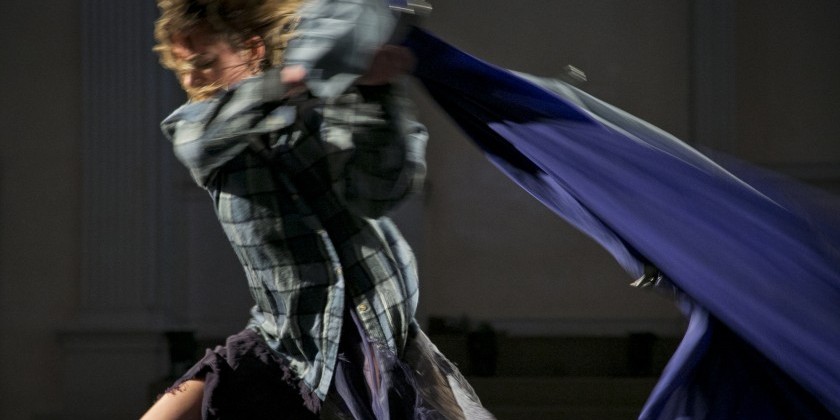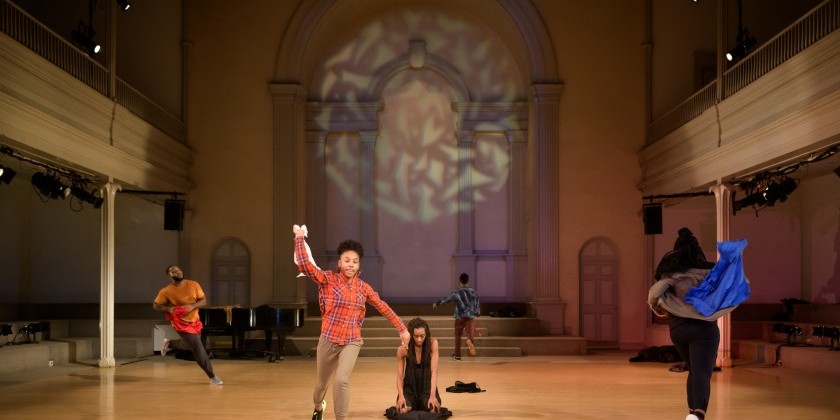TDE Asks Aynsley Vandenbroucke about Dance, Words and Her Premiere “And” at Abrons Art Center

And premieres March 30-April 2 at Abrons Art Center.
For tickets, go to: www.abronsartscenter.org
In her new performance And, Aynsley Vandenbroucke uses experimental literary devices to create a series of live, three-dimensional essays. Vandenbroucke plays with lines between fact and fiction, narrative and abstraction, legibility and complexity. She works with — and against — the role of formal structures in writing, moving, and making a life. Some words that tussle for importance in the piece are art, life, body, marriage, knowing, divorce, uncertainty, gentleness, power, sex, and dance.
Trina Mannino for The Dance Enthusiast: When did you develop an interest in writing and literature?
Aynsley Vandenbroucke: From when I was really little, I loved creative writing and coming up with short stories. But then dance took over. It seemed more pressing at the time. These last few years have been a remembering of this other love.
There was one moment after freshman year [from North Carolina School of the Arts] when I was studying in the Merce Cunningham program. I was sitting in a cafe and thinking, ‘I could obsessively try my whole life to get into a big company like Cunningham or I could become Cunningham.’ I didn’t think I could actually be as great as him, but it was more the realization that I could invent my own rules. That thought hadn’t occurred to me before then.
TDE: How is And different from your previous work?
AV: I’m playing with more outright storytelling in this piece, and that’s been both confusing and fun. I'm using writers like Spalding Gray as a jumping off point. A friend told me to check out Grey after seeing my piece at Danspace. [In Vandenbroucke’s 2011 Danspace work, she is seen sitting at desk similar to the environment that Gray often created to tell stories in performance.]
I’m grappling with how in moments I’m just telling a story while in others I’m using this dancer-ly abstract sensibility. I’m confused how these two approaches relate or don’t.
TDE: In your press release you mention that you nod to constraint-based “potential” literature? What is that?
AV: It was created by these writers in France who call themselves the Oulipo. Georges Perec, for example, wrote an entire book without using the letter E. Another example is a book that only has one paragraph and that same paragraph is told over and over in many different styles.
It’s so geeky and fun.

TDE: When I hear the word constraint, I think of the word rule. Did you give yourself constraints or rules within this piece?
AV: More than utilizing constraints, And is a reflection on constraints and form.
This piece is also partly a reflection of a divorce that I went through. In one sense marriage is a type of constraint and within its structure, it allows for freedom, but what happens when it dissolves? We built a space together. [Vandenbroucke founded Mount Tremper Arts in the Catskills with her former partner Mathew Pokoik]. Some of the storytelling refers to the actual building of that space and then things falling within that.
TDE: Do you feel that this project is a turning point in your creative process?
AV: This is the longest it’s been since I’ve made something. There is four years of thinking, reading, and digesting a number of ideas that I’ve experienced through teaching that is trying to find its way out right now.
It feels very new partly because it’s mostly been only me. In the past, my work has been very collaborative right from the beginning, but in this project, it’s often me reading in my living room alone.
Each time I approach a new work, I try to figure out what performance actually is. It can be torture. But it’s the [proverbial] banging your head on the table and figuring what it all means that really interests me.
TDE: You teach in the dance department at Princeton University. What do your classes look and feel like?
AV: I teach a few courses and one is called “Power, Structure and the Human Body.” Almost none of the reading is about dance, but it all relates to bodies, power or structure. We usually start with an improvisation or physical experience. We then have a conversation about the readings. There’s a vulnerability and honesty that they’re more prone to because of what they experienced together.
Another course is called "Being and Doing." One day each term the only rule is that they are here for two hours. Other than that, as long as they don’t hurt themselves or others, they are free to do what they like. It’s magical. We could question what this has to do with dance, but it’s really a fundamental part of the creative process — going in and not having any information or rule but needing to generate things from yourself.
TDE: How does teaching relate to your own creative practice?
AV: I tell my students that virtuosity is often in the ideas instead of the physical experience…
And I’ve realized that the things that I’ve told them, I have to accept in my own work. For example, it’s ok if it fails.
I’ve also been thinking about the kinds of authority and strength that I believe in. It’s a kind of quiet, spiritual strength, but not in a cheesy way. When I’m teaching sometimes it feels like I’m barely there. Though I have created the environment, it feels like the students are running it. It’s a quiet embodied sense of trusting the world and looking at the people around you and inviting them in.
TDE: What does an And rehearsal look like?
AV: I’ve been thinking about that word ‘rehearsal’ and how it relates and is different from ‘creating’. I’m reading tons and tons especially writers who are working at the intersection of art and theory like Maggie Nelson. Beautiful writers and thinkers — I feel like I’m collaborating with them in my mind. It’s a lot of me reading on my couch then going to the computer to write something and making videos of carrying around this desk around [a set piece in the work].
I wrote a friend and asked him to make up rules for me to follow in my next rehearsal. I created some material based on that. I had friends come into the theater and drink wine and see how that could generate ideas. Part of this process is seeing what a rehearsal could look like.
Another goal of this piece is it had to be pleasurable to work in. It makes no sense to make these things if they’re torture all of the time [laughs].
TDE: What are you drawn to when witnessing other people’s work?
AV: I’m looking for new ideas on what performance could be or an investigation of a big idea in life. Work doesn’t need to impress me or be technically perfect. If I feel that the artist is grappling with something that makes me think then I’m excited.
1. Art After Philosophy by Joseph Kosut
The Dance Enthusiast Asks Questions and Creates Conversation.
For more of The Dance Enthusiast Asks, click here.
Share your #AudienceReview of this performance or others for a chance to win a $75 giftcard to Trader Joe's.













